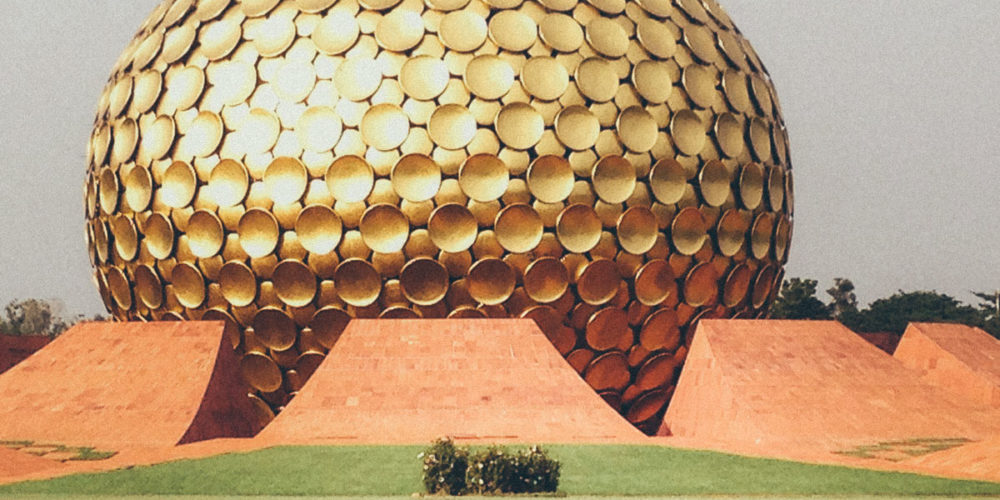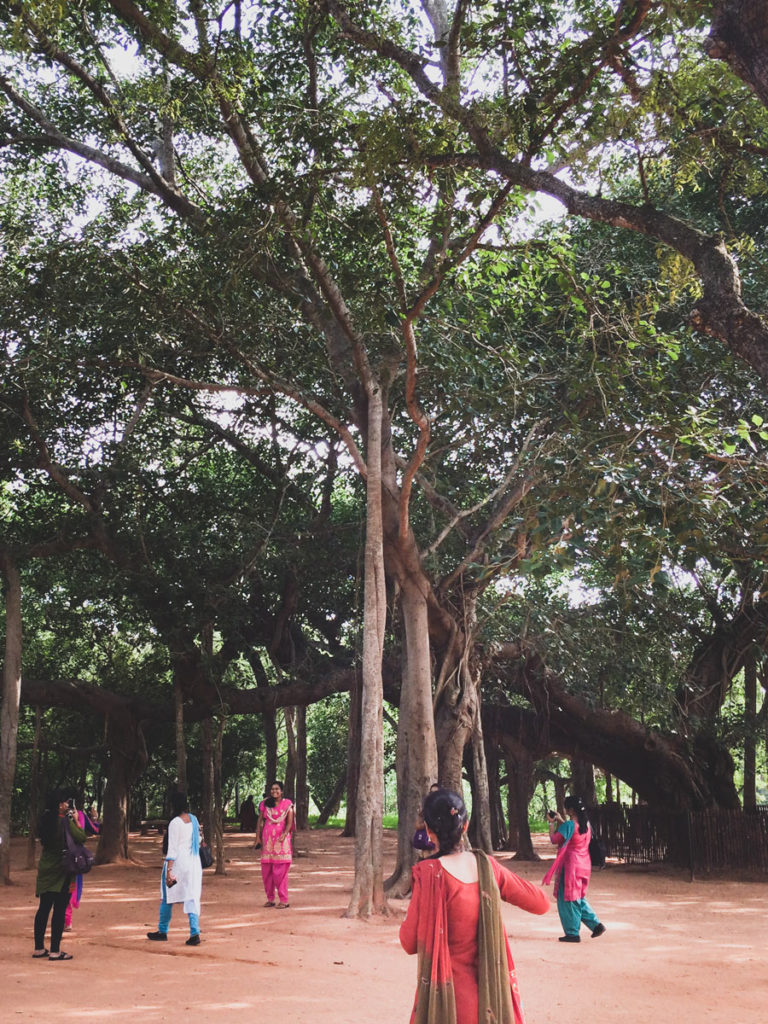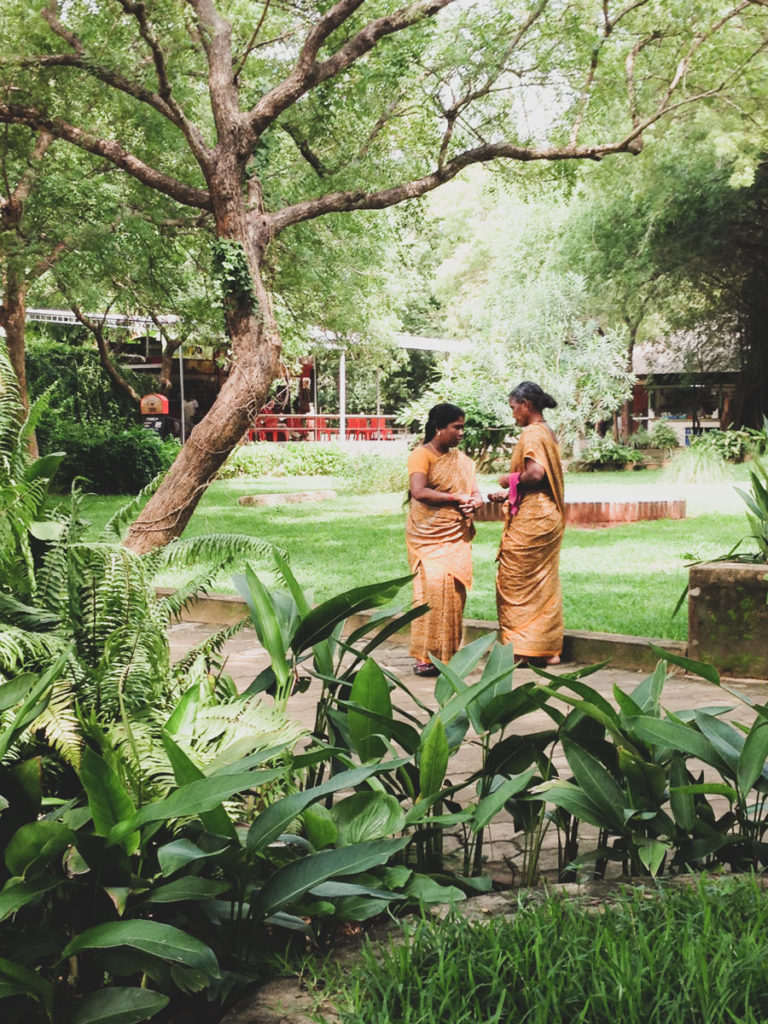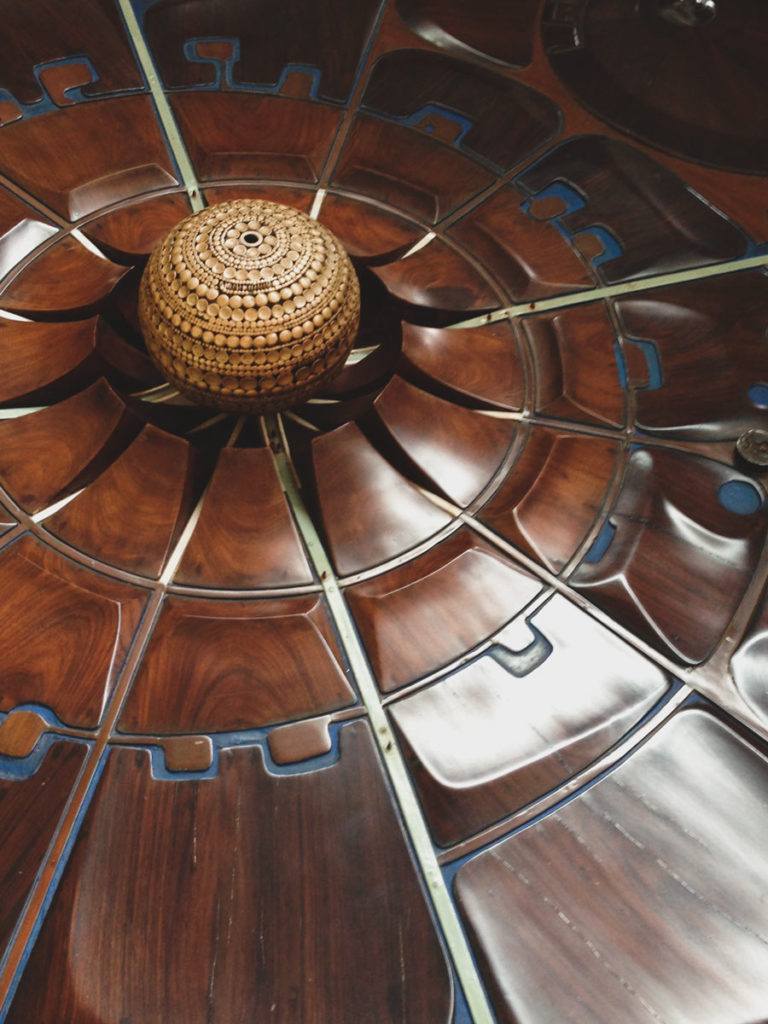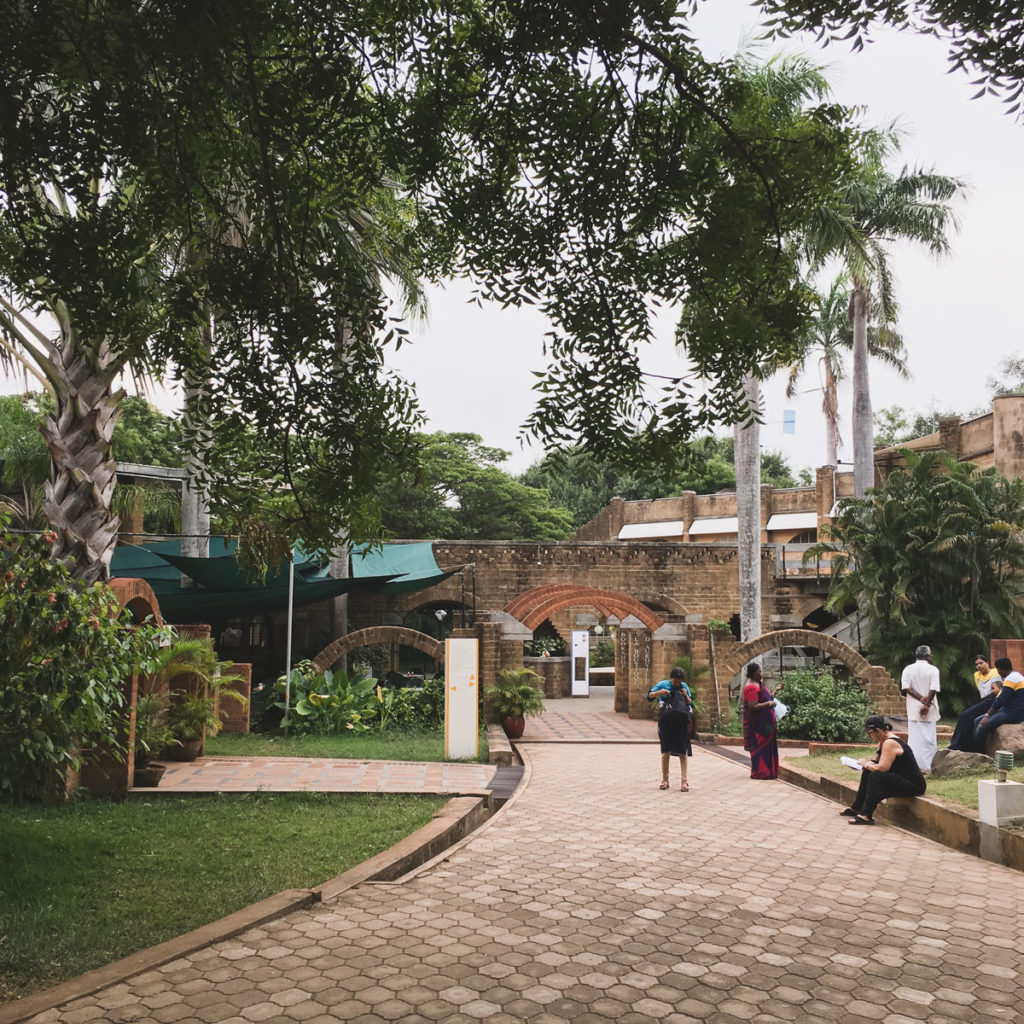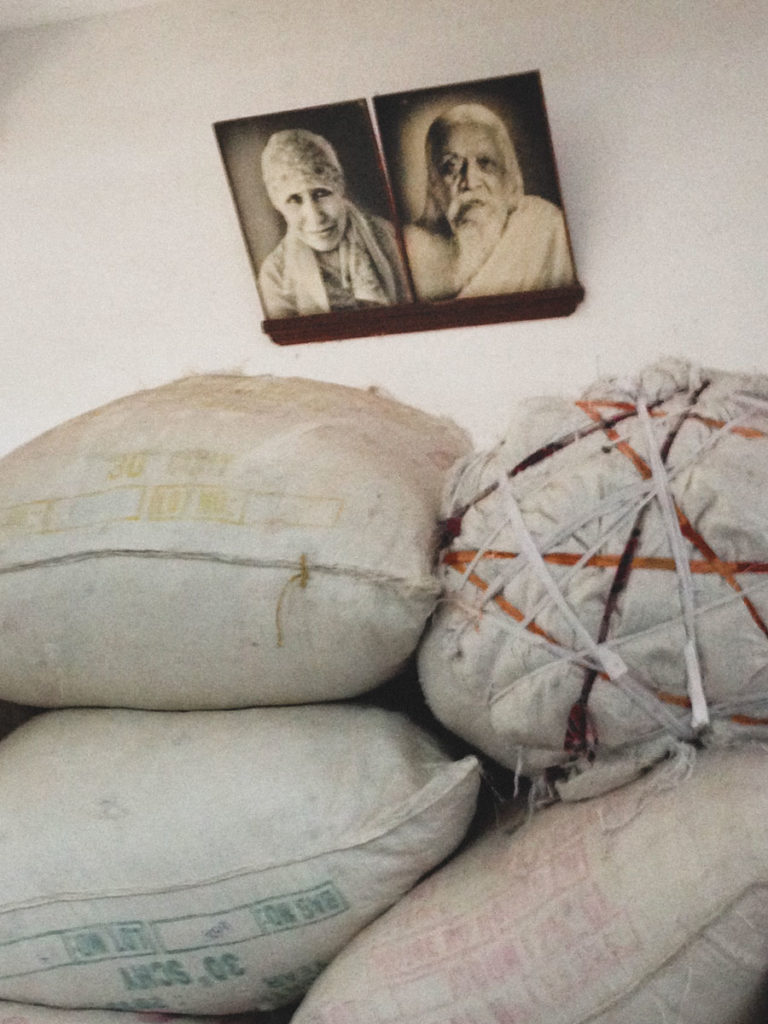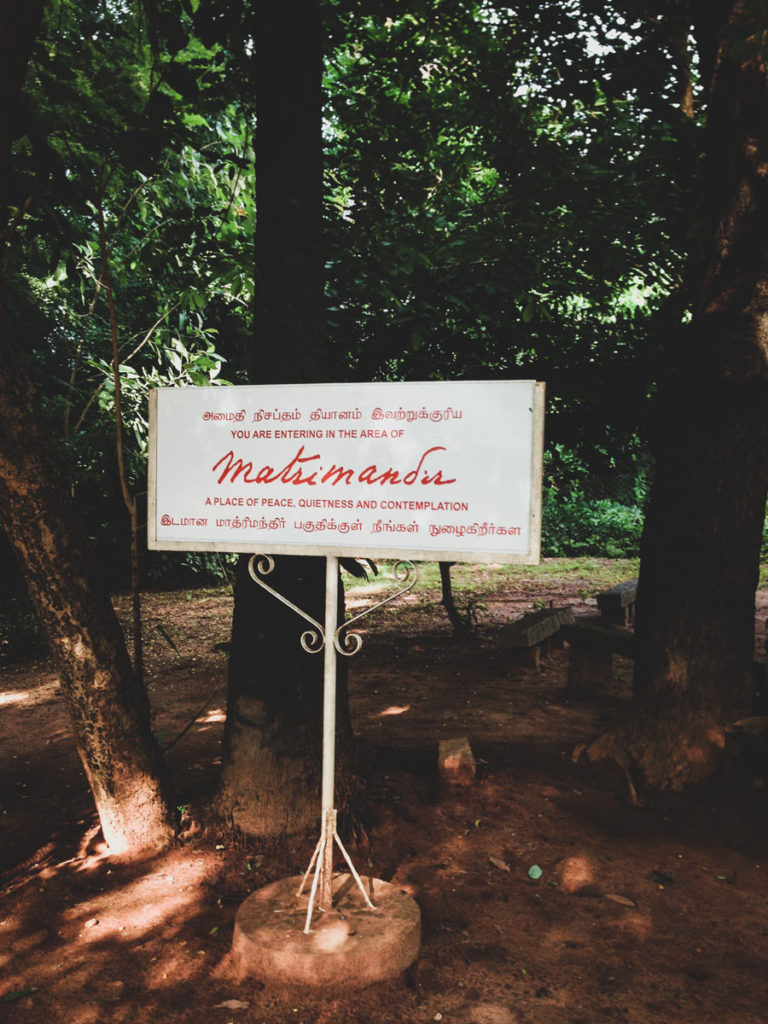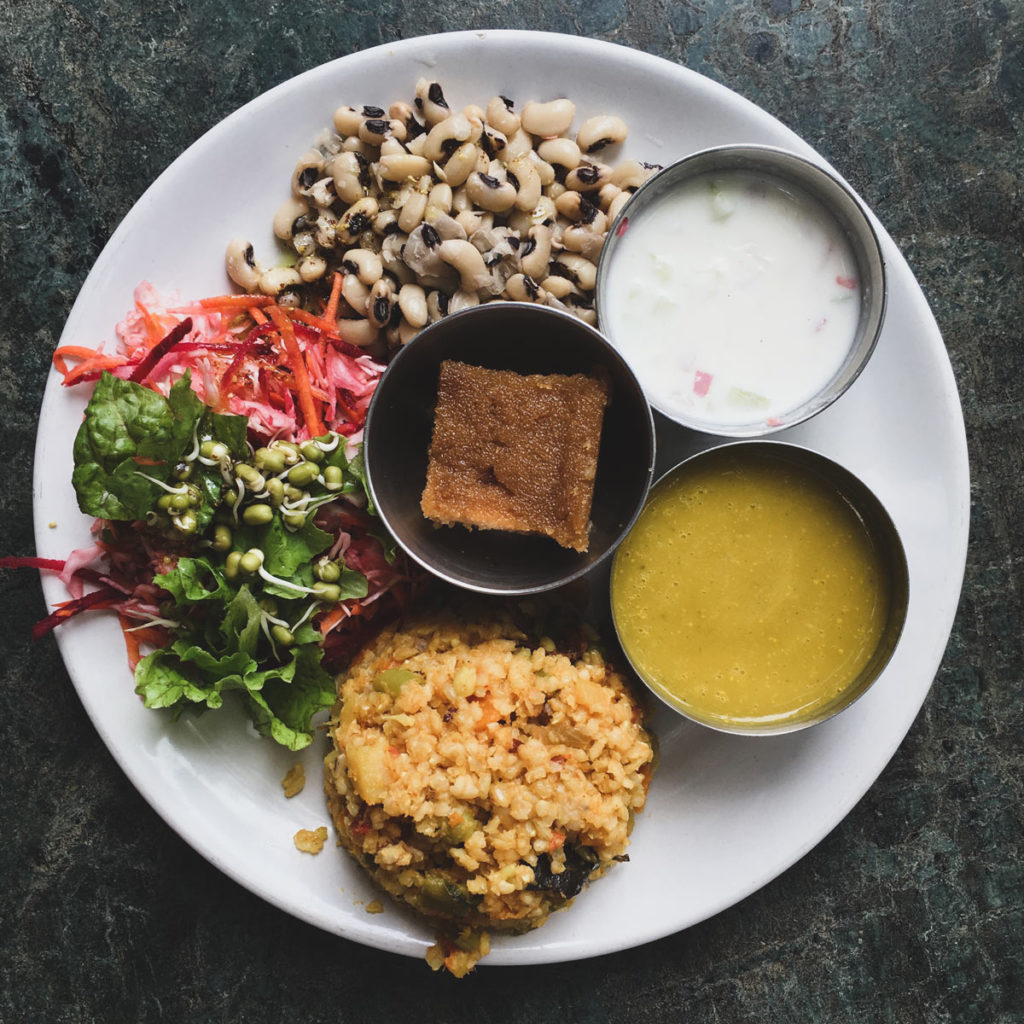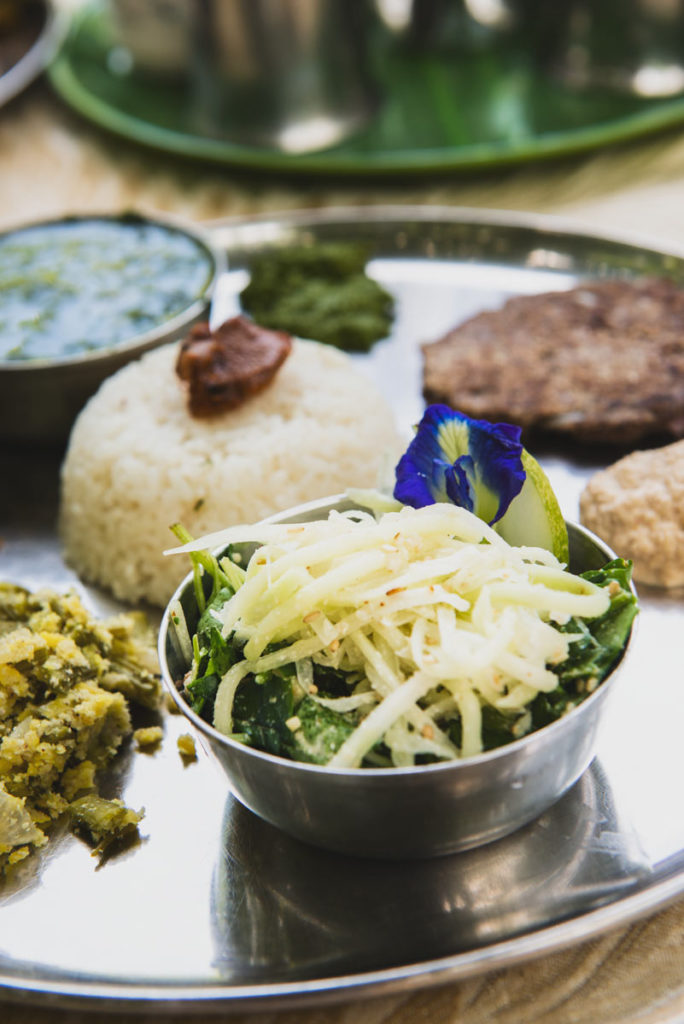Imagine a vast plain of dry, fissured red earth baking like clay under the hot sun. It collapses and erodes under the weight of each South Indian monsoon. Scruffs of grass are the only growth it bears after decades of deforestation. Visiting the city of Auroville now, you’d never guess that this was the condition of the place when the land was purchased in 1968 by the leader of Puducherry’s Aurobindo Ashram.
Auroville lies 12 kilometres north of Puducherry (formerly Pondicherry) on the way to Mamallapuram. A small barely noticeable sign marks the turn off the East Coast Highway. From here, you head due west for six kilometres along a narrow road dotted with a few shops, restaurants and bakeries before arriving at a red dirt parking lot surrounded by towering eucalyptus trees.
Visiting
On our first visit in 2014, the South Indian heat was sweltering. Well, that is, by Canadian standards. Admittedly, the Tamil people looked completely comfortable.
Wide brimmed straw hats were all that kept us from looking like candy red apples as we strolled a kilometre on a shaded earthen path towards the meditation centre. Water began to trickle out of every pore when suddenly we emerged from the dense forest. We were expecting a low subdued wooden building but there, across a wide moat of manicured lawn, was a giant golden golf ball of a building.
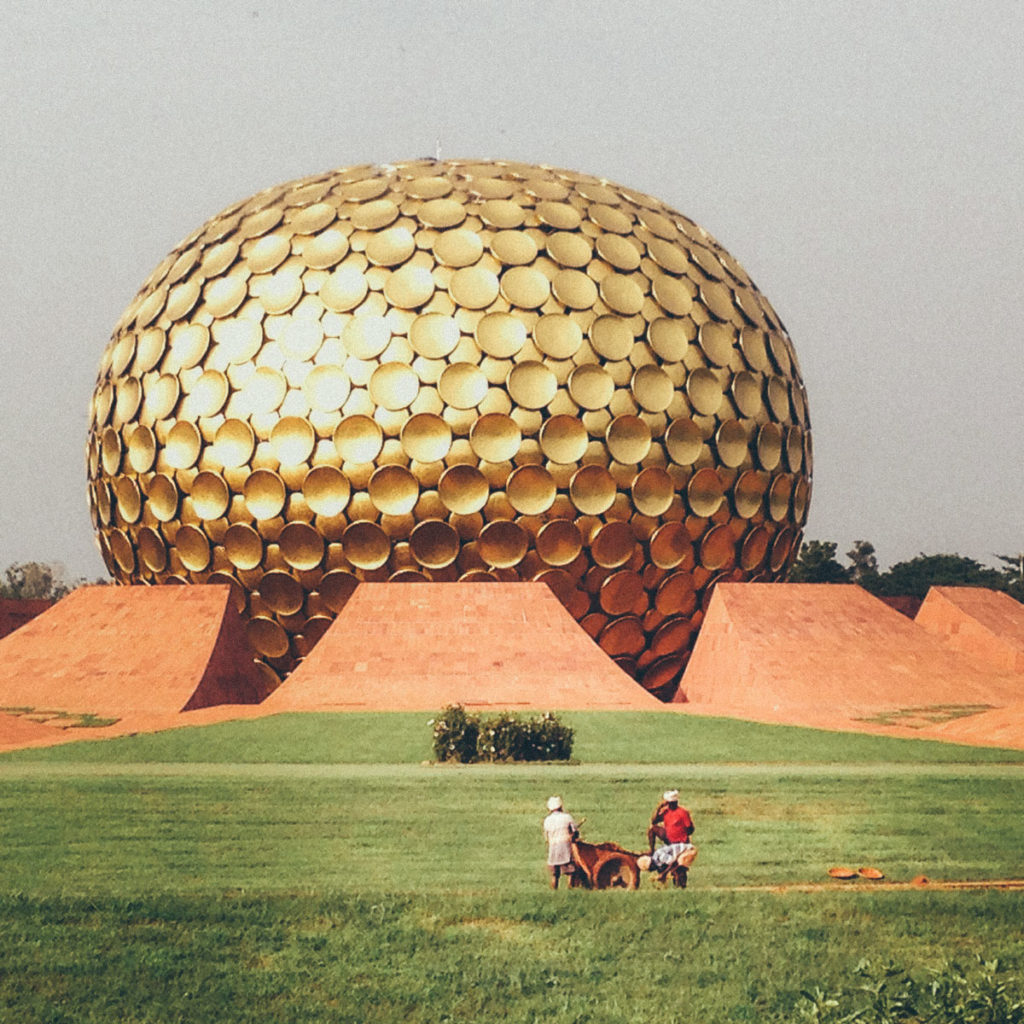
It was startling. We forgot the heat. Staring at the golden orb front and center, we began to wonder what this place was really all about.
The few paragraphs in our guide book described Auroville as an international community for people devoted to raising human consciousness. We’d heard rumours that it was a commune for retired hippies.
Now we learned that the complex golden honeycomb structure in front of us was called The Matrimandir. It’s a Sanskrit word meaning “Temple of the Mother” and it’s not only the meditation centre for the residents, it’s also considered the soul of the city.
Neither of us had done much meditation. Frankly, I thought of consciousness as the opposite of sleep. Pauli-Ann and I both wanted to learn more.
Dripping wet, we plowed back to the interpretive centre through the heavy air of a wall of humidity that was building courtesy of late monsoon season. Sighing with relief at the air-conditioning, we wandered through the pavilion that housed a model of the community and explanations about the founders and their vision. Here’s a summary of what we learned, so that if you go you can be better informed than we were on that our first visit.
Auroville Backgrounder
The founders of Auroville were a politician turned poet and sage, Sri Aurobindo, and a French woman and spiritual seeker, Mirra Alfassa, who later became known as “The Mother.”
Sri Aurobindo
Born Aurobindo Ghose in Kolkata, he had agitated for India’s Independence during the British Raj with covert organizations and overt writing. Life as a rebel landed him in prison for over a year. During that time, he had profound meditative experiences that led him to develop a practice called Integral Yoga. After his release, he left British India and moved to the French colony of Pondicherry to leave politics behind and practice Integral Yoga full-time. His writings on the topic attracted followers.
Delving deeper, Aurobindo believed the world could evolve with a new species, far above humans, just as humans have surpassed animals. He believed the end goal of spiritual practice could not merely be a liberation from the world into Samadhi (union with the divine) but would also be that of a descent of the Divine into the world, in order to transform it into a Divine existence. This became the purpose of Integral Yoga.
Regarding the involution of consciousness in matter, he wrote: “This descent, this sacrifice of the Purusha, the Divine Soul submitting itself to Force and Matter so that it may inform and illuminate them, is the seed of redemption of this world of Inconscience and Ignorance.”
Sri Aurobindo believed that Darwinism merely describes a phenomenon of the evolution of matter into life, but does not explain the why. Aurobindo argues that nature, the divine, has evolved life out of matter and the mind out of life. He believed all of existence was attempting to manifest to the level of the supermind – that evolution has a purpose or goal.
Aurobindo did most of his teaching through letters to his followers. There are over 30,000 letters. And there his teachings and vision for humanity may have ended, had it not been for one French woman named Mirra Alfassa.
Mirra Alfassa – “The Mother”
This French national came to Pondicherry a few times, met Sri Aurobindo, and eventually stayed to organize and run his ashram. Because he found her to be his spiritual equal, he appointed her as his successor.
Alfassa’s goal was to create a physical manifestation of Sri Aurobindo’s great teaching, “all nations are essentially one and meant to express the Divine Unity upon earth through an organized and harmonious diversity.”
As mentioned at the outset, The Mother founded Auroville, or City of Dawn, in 1968. It is meant to be a place for humanity not to escape life to access the divine, but instead, to live in such a way, to evolve, so that humanity brings the divine to life while it’s lived.
Auroville today
Auroville is currently about 20 square kilometres (about 5000 acres). As of January 2018, there were 2,814 residents (2127 adults and 687 children) from 54 countries – according to the Indian census.
At the centre of the land lies the metallic sphere we were so impressed by – The Matrimandir. It was conceived by Alfassa as “a symbol of the Divine’s answer to man’s aspiration for perfection”.
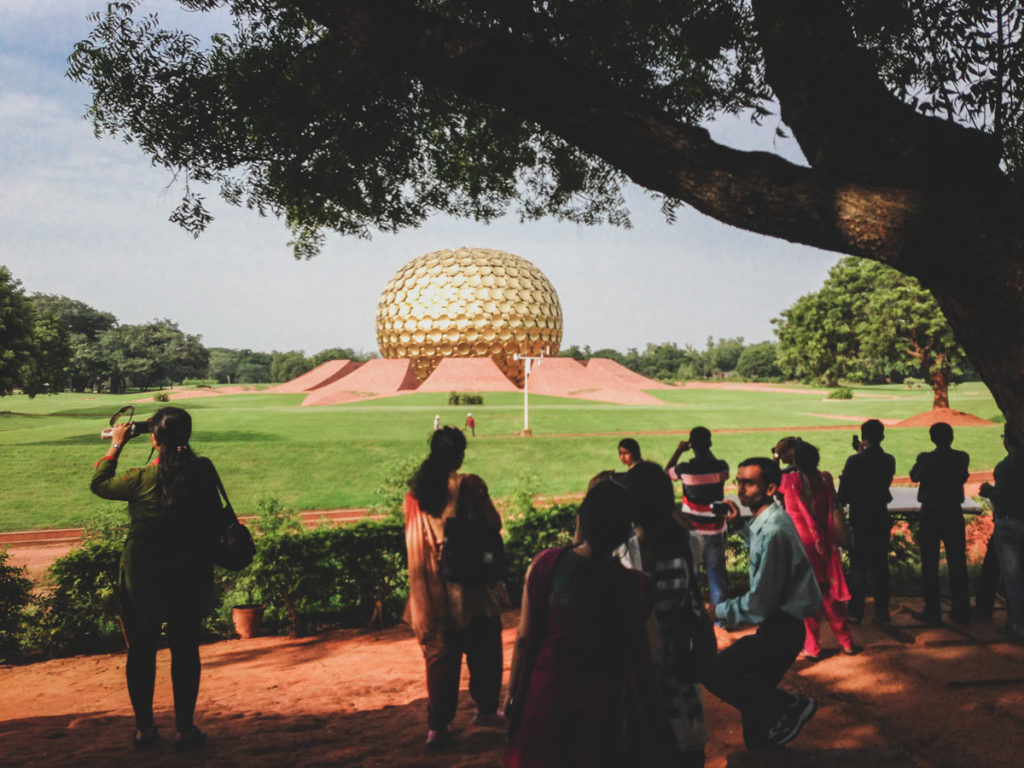
Silence is maintained inside to ensure the tranquility of the space. A spiral ramp in the interior leads to an air-conditioned white marble chamber where a sun ray falls on a globe. It was designed as a place for meditators to find their consciousness.
The building is equipped with a solar power plant and is surrounded by manicured gardens. When there is no sun or after sunset, the sunray on the globe is replaced by a beam from a solar powered light.
Radiating from The Matrimandir are four zones: residential, industrial, cultural and international. The city is surrounded by a Green Belt which is an environment research and resource area and includes farms and forestries, a botanical garden, seed bank, medicinal and herbal plants, water catchment areas and some communities.
The Charter
Mirra Alfassa, The Mother, wrote a four-point charter to set forth her vision of integral living as follows:
- Auroville belongs to nobody in particular. Auroville belongs to humanity as a whole. But to live in Auroville, one must be the willing servitor of the Divine Consciousness.
- Auroville will be the place of an unending education, of constant progress, and a youth that never ages.
- Auroville wants to be a bridge between the past and the future. Taking advantage of all discoveries from without and from within, Auroville will boldly spring towards future realisations.
- Auroville will be a site of material and spiritual researches for a living embodiment of an actual Human Unity.
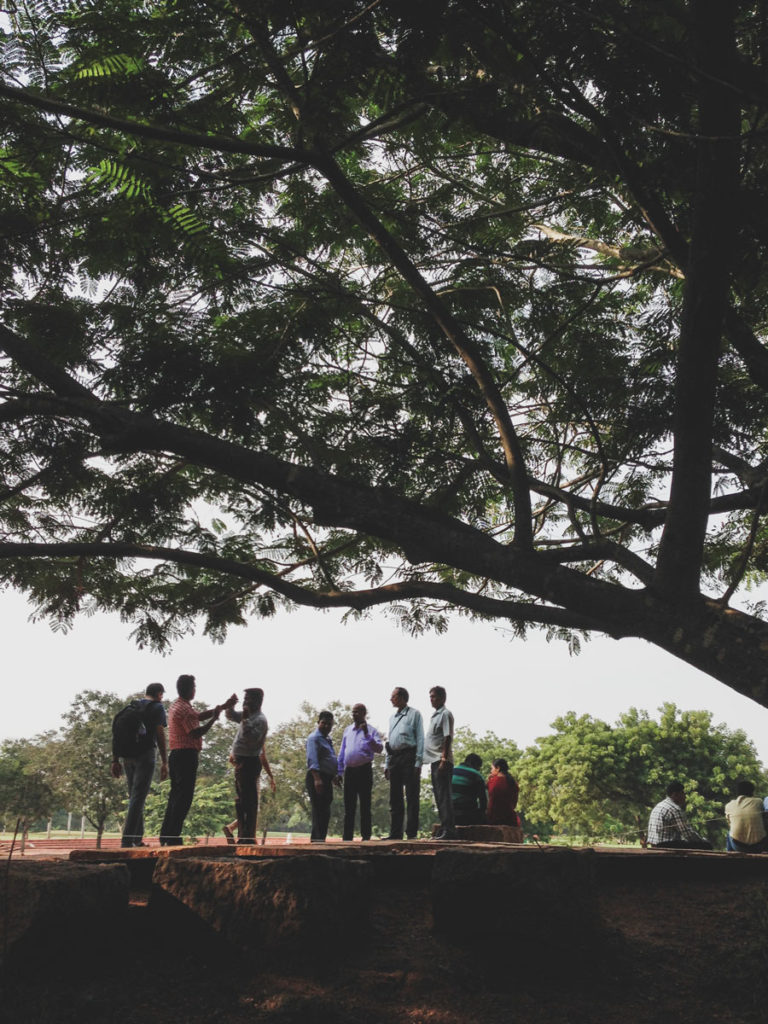
Auroville, the reality
Can people actually live this way? The original vision was for Auroville to be a community of about 50,000 people. After The Mother died in 1973, there was conflict in the community and in 1980 the Sri Aurobindo Society appealed to the Indian Government for an intervention.
The Auroville Foundation Act was passed by the Indian Parliament in 1988. It stipulates the vesting of all movable and immovable assets of the city in a foundation, known as Auroville Foundation and the creation of a three-tier governing system: the Governing Board; the Residents’ Assembly and the Auroville International Advisory Council.
The highest authority is the Governing Board selected by the Government of India. It consists of seven prominent Indians in the fields of education, culture, environment and social service. The second authority is the International Advisory Council whose five members are also selected by the Government. These are chosen from people who have rendered valuable service to humanity in the areas of Auroville’s ideals. The Resident’s Assembly consists of all official residents of the city.
The justification for the government’s action is that Auroville is in “conformity with India’s highest ideals and aspirations.” The Indian government donates more than $200,000 to Auroville every year, and UNESCO has protected the township since its birth in 1968.
Maintenance and growth for the future
Instead of paper and coin currency, residents are given account numbers to connect to their central account. They make a monthly contribution to the community and are asked to help the community whenever possible by work, money, or kind.
“Although the Government of India owns and manages the Auroville Foundation, it only finances a small part of Auroville’s budget, which is mainly formed by contributions from Auroville’s commercial units which contribute 33 per cent of their profits to Auroville’s Central Fund, and by donations.”
Guests pay a daily fee. There are guest houses, building construction units and information technology. Small and medium scale businesses produce and sell items such as handmade paper for stationery items, incense sticks, clothing, jewelry and food which can be bought in Auroville, at the ashram in Puducherry, around India and abroad. Each of these business units contributes a considerable part of their profits to the township. Over 5,000 people, mostly from the nearby localities, are employed in various sections and units of Auroville.
Other activities include afforestation, organic agriculture, basic educational research, health care, village development, appropriate technology, town planning, water table management, cultural activities, and community services. The government of India gives Auroville research projects for sustainability and Auroville is involved in outreach and empowerment projects throughout the country.
Dusk in the City of Dawn
We decided to round out our afternoon in Auroville by contributing to its commerce with the purchase of lunch and shopping. The quality of the paper, jewelry, clothing and food available is organic and artisan. Fine shops around India carry clothing, paper and jewelry all made in Auroville.
As the heat of the day started to diminish, we mercifully found ourselves on the shaded terrace of a cafe called “The Right Path” lunching on vegan glory bowls of bright purple, orange and green organic vegetables. We started a conversation with the two men sharing our table. They asked where we were from and how long we’d be there. Canada, we said, and just here for the afternoon. Returning the polite banter, as travellers do, we were more than a little surprised when they said, We’re from Sweden and we came here in the 70s and never left.
There was so much we wanted to ask them. But their faces told their story – bright eyes, clear skin, smiling face, relaxed and engaged attitude. For 40 plus years they’d lived here and, in our brief conversation, it seemed they were the living embodiment of the charter “The Mother” had set out for them.
Dusk comes quickly in the tropics. As we pulled out of Auroville and headed south to Puducherry the sun faded but the City of Dawn would stick in our minds permanently. We hope you enjoyed reading this post, and about the faces of Auroville. We feel we understand the place and the people it attracts better now.
There’s just one Auroville quest left for us (well, beyond returning to support all those wonderful shops and restaurants). On our next visit in 2020, we hope to enter the inner sanctum. We’d like a chance to meditate in the Matrimandir.

Gratitude
Thank you to the KTM Society and Travel XS for sponsoring our travel throughout South India in 2016.
All words and photos are our own and were not shared with the sponsors before publication.

